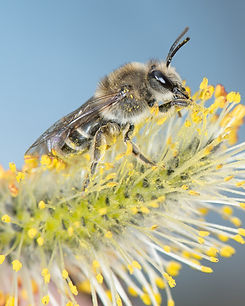
Family Megachilidae > Genus Coelioxys
Coelioxys
Sharp-tailed Cuckoo Bees
In Minnesota, there are twelve described species within the genus Coelioxys. Bees in this genus are cleptoparasitic (cuckoo bees), and their hosts are bees in the genus Megachile. Coelioxys are present in their host's habitat, visiting flowers near host nests. Like other cuckoo bees, females will perch on an object or vegetation establishing a vantage point from which they can monitor the host nest(s). When the host leaves to collect provisions or nesting materials, Coelioxys females enter the nest. Using the sharp point on the end of their abdomen, they pierce a hole in the brood cell leaf (or petal) lining, then lay an egg concealed in the nest materials. The first instar larva develops large sickle-like mandibles that are used to destroy the host egg (or larva). It then develops within the brood cell, feeding on the pollen provisions provided by the host bee. The larvae sheds the large mandibles after the first instar stage. Their hosts, bees in the genus Megachile, either nest aboveground in cavities or belowground, often under an object such as a flat rock.
Coelioxys are dark gray or black bees with white hair bands on the abdomen. They have hairs on their compound eyes and often red legs; some species have red markings on their abdomen. Females have a sharp point on the end of their abdomen, and males have multiple tooth-like prongs on the end of their abdomen. Bees in this genus range in length from 5 to 17 mm (0.2 to 0.7 inches).

A Coelioxys female visiting Achillea millefolium.

A Coelioxys male visiting Verbena hastata.

wing
position
on flowers

N0. species in MN
12
size range

Phenology

Genus Characteristics

Hairs on compound eyes.

Males with multiple tooth-like prongs on the end of the abdomen.
male

Females with sharp pointed abdomen; males and females with pointed axillae.
female

female
Dark gray or black integument with white hair bands on the abdomen. Legs often red.
Distribution

Coelioxys alternatus

Coelioxys banksi

Coelioxys bisoncornuus

Coelioxys funerarius

Coelioxys immaculatus

Coelioxys modestus

Coelioxys moestus

Coelioxys octodentatus

Coelioxys porterae

Coelioxys rufitarsis

Coelioxys sayi

Coelioxys sodalis
Coelioxys Species in Minnesota
Scientific Name | Host |
|---|---|
Coelioxys alternatus | Megachile pugnata (Gibbs 2023, Satyshur et al. 2023) |
Coelioxys banksi | Megachile |
Coelioxys bisoncornuus | |
Coelioxys funerarius | Megachile (Gibbs 2023) |
Coelioxys immaculatus | Megachile |
Coelioxys modestus | Megachile campanulae (Gibbs 2023, Satyshur et al. 2023) |
Coelioxys moestus | Megachile (Gibbs 2023) Megachile relativa (Satyshur et al. 2023) |
Coelioxys octodentatus | Megachile (Gibbs 2023) Megachile rotundata (Satyshur et al. 2023) |
Coelioxys porterae | Megachile (Gibbs 2023) |
Coelioxys rufitarsis | Megachile (Gibbs 2023) |
Coelioxys sayi | Megachile |
Coelioxys sodalis | Megachile (Gibbs 2023) Megachile mendica (Satyshur et al. unpublished) |
Source: Minnesota Department of Natural Resources, Minnesota Bee Species List (August 2023).
https://files.dnr.state.mn.us/eco/mcbs/mn-statewide-bee-list.pdf
University of Minnesota Native Bee Altas: https://minnesotabeeatlas.umn.edu/species-guide/bees/coelioxys
Explore More Megachilidae Genera
Note: Two genera/species on the state list are not included in this guide: Ashmeadiella bucconis (last seen in Minnesota in 1949) and Trachusa zebrata (last seen in Minnesota in 1939). If either of these species is rediscovered in the state, they will be added to the guide at that time.
Explore Bee Families

Apidae
15 genera, 133 species
Bumble bees Bombus
Longhorn bees
Epimelissodes, Eucera, Melissodes
Carpenter bees
Ceratina, Xylocopa
Honey bees Apis
Digger bees Anthophora
Cuckoo bees Brachymelecta, Epeolus, Holcopasites, Nomada, Neolarra, Triepeolus
Squash bees Xenoglossa

2 genera, 39 species
Halictidae
10 genera, 133 species
Metallic green sweat bees
Agapostemon, Augochlora, Augochlorella, Augochloropsis
Large sweat bees
Dieunomia, Nomia
Short-faced bees Dufourea
Sweat bees Halictus
Small sweat bees Lasioglossum
Cuckoo (blood) bees Sphecodes
Megachilidae
14 genera, 86 species
Resin and pebble bees Anthidiellum, Dianthidium, Heriades, Paranthidium
Carder bees Anthidium, Pseudoanthidium
Mock orange bees Chelostoma
Mason bees Osmia, Hoplitis
Leafcutter bees Megachile
Sharp-tailed cuckoo bees Coelioxys
Dark cuckoo bees Stelis

Citations and Further Reading
Droege, S., et al. (2024). The Very Handy Bee Manual: 2.0. How to Catch and Identify Bees and Manage a Collection.
Gibbs, J., Hanuschuk, E., Miller, R., Dubois, M., Martini, M., Robinson, S., ... & Onuferko, T. M. (2023). A checklist of the bees (Hymenoptera: Apoidea) of Manitoba, Canada. The Canadian Entomologist, 155, e3.
Mitchell, T. B. (1960). Bees of the eastern United States. Technical Bulletin No. 141. North Carolina Agricultural Experiment Station.
Portman, Z. M., Gardner, J., Lane, I. G., Gerjets, N., Petersen, J. D., Ascher, J. S., ... & Cariveau, D. P. (2023). A checklist of the bees (Hymenoptera: Apoidea) of Minnesota. Zootaxa, 5304(1), 1-95.
Satyshur, C. D., Evans, E. C., Forsberg, B. M., Evans, T. A., & Blair, R. (2023). Determining Minnesota bee species’ distributions and phenologies with the help of participatory science. PeerJ, 11, e16146.
Wilson, J. S., & Messinger Carril, O. J. (2016). The bees in your backyard: a guide to North America's bees. Princeton University Press.
Page Photography Credits
Heather Holm
















